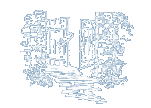



 | 


|
|
Guests of the OakThe oak feeds more creatures than any other English tree. Not only do the pigs, the hedgehogs, the squirrels, and the field-mice feed on the acorns, but more than fifty kinds of insects get their food from some part of the tree. Many of these are too small for you to find, but you will enjoy looking out for others. If you examine an oak-tree in May, you will most likely find some of its leaves rolled up, either from the tip towards the stalk, or from side to side. Undo this roll and you will find a caterpillar inside, or perhaps a chrysalis. There are two kinds of caterpillars which roll up oak leaves. One, which is called simply the Oak-moth caterpillar, is large. It rolls up the leaf rather untidily, and spins a cocoon round itself inside, in the shape of a little boat. The moth when it comes out has bright green wings with two white bands on them.
The other caterpillar, which you are almost sure to find, does its work more tidily. It makes a very neat roll, and fastens it together with fine threads. Then it feeds on the inner rolls till it goes to sleep, and turns into a moth. If you shake an oak-tree in June numbers of these little moths will often fly out. They are called the Green Oak-moth, though their hind wings are brown. They are much smaller than the oak-moth, whose caterpillar spins the boat cocoon. Another insect which you may find, is the grub of the great Stag Beetle. For this you will have to cut into the trunks of old trees, where the big grub hollows out a bed for itself under the bark. It stays there and feeds on the wood of the tree for three or four years, till it turns into the beetle. You remember that the woodpecker taps with his beak as he climbs the trees. It is grubs like these that he is trying to find.
But the most curious homes on an oak-tree are the galls made by mother insects, which lay their eggs on some part of the tree. Every country child knows the red-brown rosy-cheeked oak-apple, which grows on the tips of the oak-twigs, and which many people mistake for fruit. Boys used to stick these in their hats on the twenty-ninth of May, because Charles the Second, who hid from his enemies in an oak-tree, came back to his throne on that day. Instead of sticking it into your caps, cut the oak-apple across with a sharp knife. You will find that it is soft and spongy, and is divided into a number of small cells. In each of these cells there will be either a grub, or a cocoon, or a perfect fly ready to come out. Or perhaps the home may be empty, all the inmates having flown away. Let us see how this oak-apple came to be there. Early in the spring a small wasp-fly, called a Cynips, settled on the twig, and pierced the bark with a sharp-pointed tube. She carries this tube coiled up at the end of her body, till she wants to use it. Then she darts it out into the twig and squeezes some juice into the hole, together with several eggs. In a very short time a swelling rises up, and the spongy oak-apple grows round the eggs, each one being in a cell by itself. So when the grubs are hatched they find plenty of soft food to eat, till they spin their cocoons. Another of these flies lays its eggs on the loose catkins. You may easily find them hanging like little brown currants on the stalk (3, p. 39), after the flowers have withered. For though the stalk falls off as a rule, yet when these galls are on it, it remains hanging till the fly comes out. These "currant galls" have each one grub in them, and so too have the galls which you will find under the leaves. There are at least two kinds of leaf-galls. One is bright red, and is called a "cherry gall." The other is very small, pink, hairy, and flat. There are a great many of these under each leaf, and they are called "oak-spangles" (2, p.39). The grub remains in these galls after the leaves have fallen, so you will be able to find them. The next gall (1, p. 39) I am sure you will think is a bud. It is called the "artichoke gall," and really begins in the oak-bud, in which the fly lays her eggs early in the spring. Then instead of growing into a twig with green leaves, the bud covers itself with scales, and a number of grubs are hatched inside. Last of all there are the big brown galls, specially called "oak-galls" (4, p. 39). They grow half-way down the twigs, and remain hanging on the tree all the winter, after the flies have flown out. This gall was first seen in England about sixty years ago, in 1840. It has spread very fast, and is hurtful to the trees, for it sucks out a great deal of sap. It is very like the galls which we get from Asia, in order to use the acid in them for making ink.
Many other trees have galls on them besides the oak, and I advise you when you find a curious lump or a strange-shaped bud, unlike anything you expect to find on a tree, to cut it open and see if there is a grub inside. Find as many different kinds of oak-gall as you can. Find the leaf-rolling caterpillars, and try to find the grub of the stag-beetle. |


|


|